Business Management Report: Challenges and Solutions for Aurecon Group
VerifiedAdded on 2021/04/21
|18
|4589
|20
Report
AI Summary
This report presents a detailed analysis of the business management practices of Aurecon Group Pty Ltd in Singapore, focusing on the challenges of attracting and retaining skilled labor. The report begins with an executive summary and table of contents, followed by an introduction that outlines the significance of business management in today's market. A comprehensive literature review explores contemporary management challenges and retention methods, including training, mentoring, and positive organizational culture. The report also includes an industry and company analysis, synthesizing business information and identifying the application of the 7s framework to understand the challenges. The analysis reveals that Aurecon Group faces challenges related to talent acquisition and retention in the competitive consulting market. The report suggests strategic tools and alternative methods to resolve the weaknesses. The conclusion summarizes the key findings and recommendations for Aurecon Group to improve its business management practices and ensure long-term success. References and bibliography are included.
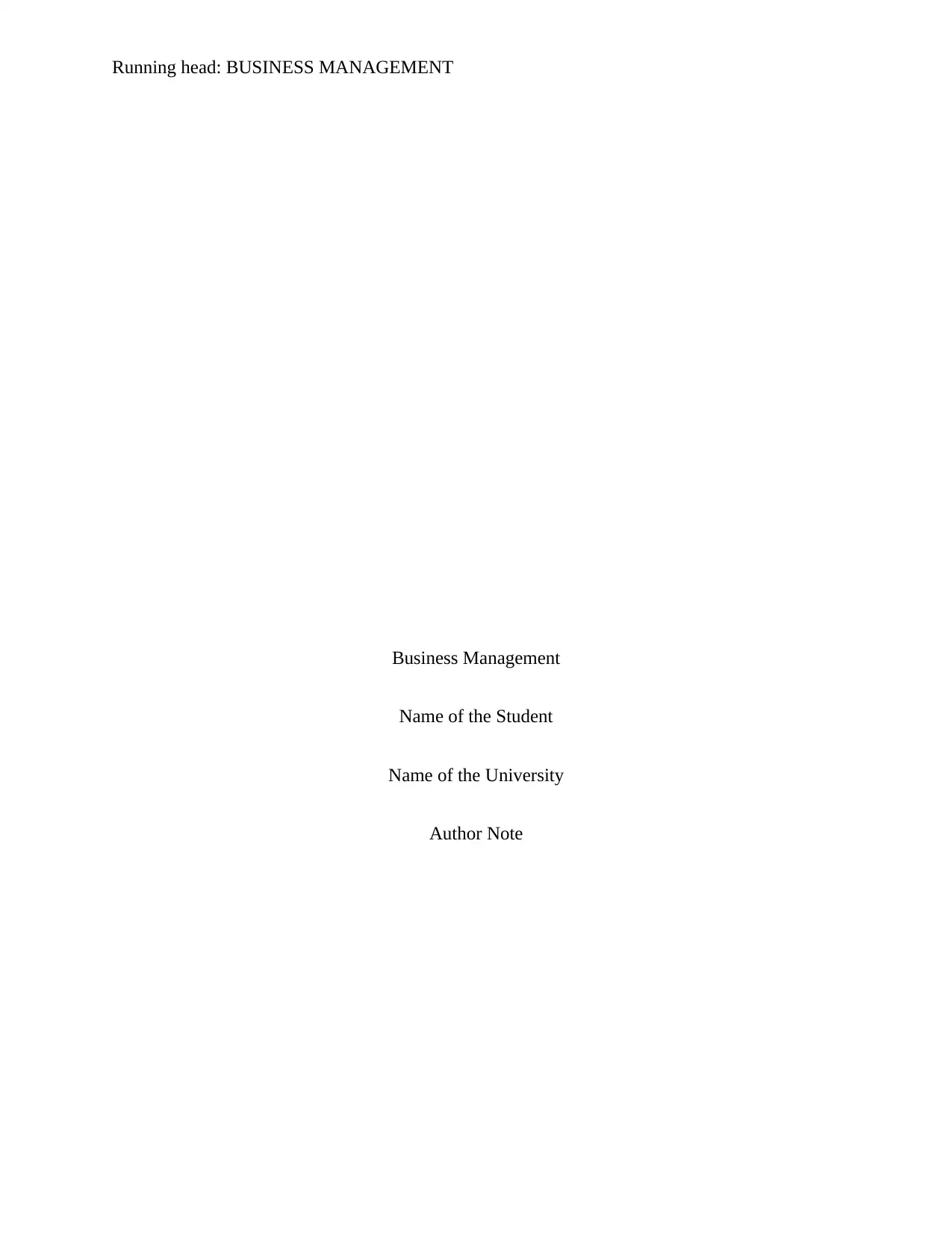
Running head: BUSINESS MANAGEMENT
Business Management
Name of the Student
Name of the University
Author Note
Business Management
Name of the Student
Name of the University
Author Note
Paraphrase This Document
Need a fresh take? Get an instant paraphrase of this document with our AI Paraphraser
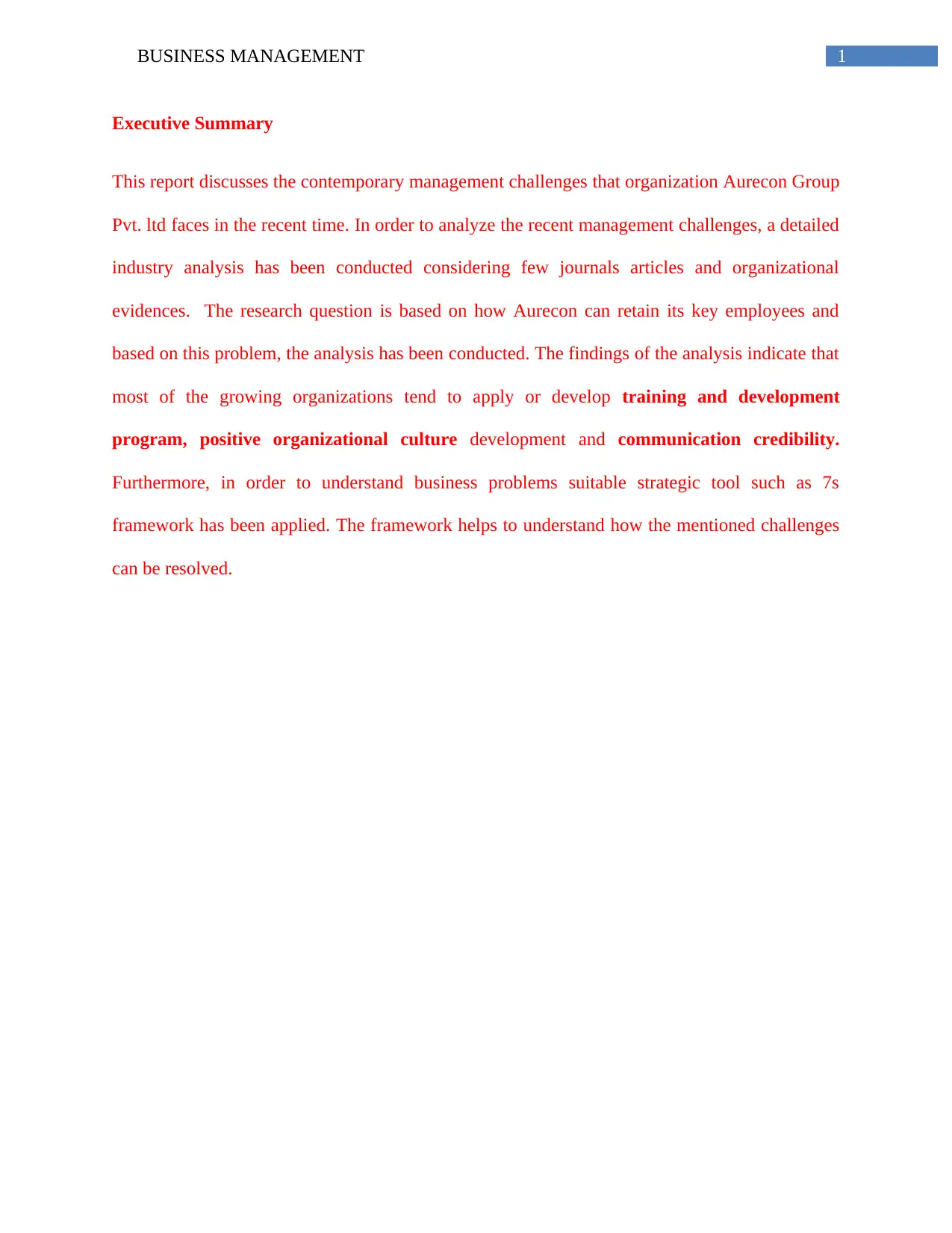
1BUSINESS MANAGEMENT
Executive Summary
This report discusses the contemporary management challenges that organization Aurecon Group
Pvt. ltd faces in the recent time. In order to analyze the recent management challenges, a detailed
industry analysis has been conducted considering few journals articles and organizational
evidences. The research question is based on how Aurecon can retain its key employees and
based on this problem, the analysis has been conducted. The findings of the analysis indicate that
most of the growing organizations tend to apply or develop training and development
program, positive organizational culture development and communication credibility.
Furthermore, in order to understand business problems suitable strategic tool such as 7s
framework has been applied. The framework helps to understand how the mentioned challenges
can be resolved.
Executive Summary
This report discusses the contemporary management challenges that organization Aurecon Group
Pvt. ltd faces in the recent time. In order to analyze the recent management challenges, a detailed
industry analysis has been conducted considering few journals articles and organizational
evidences. The research question is based on how Aurecon can retain its key employees and
based on this problem, the analysis has been conducted. The findings of the analysis indicate that
most of the growing organizations tend to apply or develop training and development
program, positive organizational culture development and communication credibility.
Furthermore, in order to understand business problems suitable strategic tool such as 7s
framework has been applied. The framework helps to understand how the mentioned challenges
can be resolved.
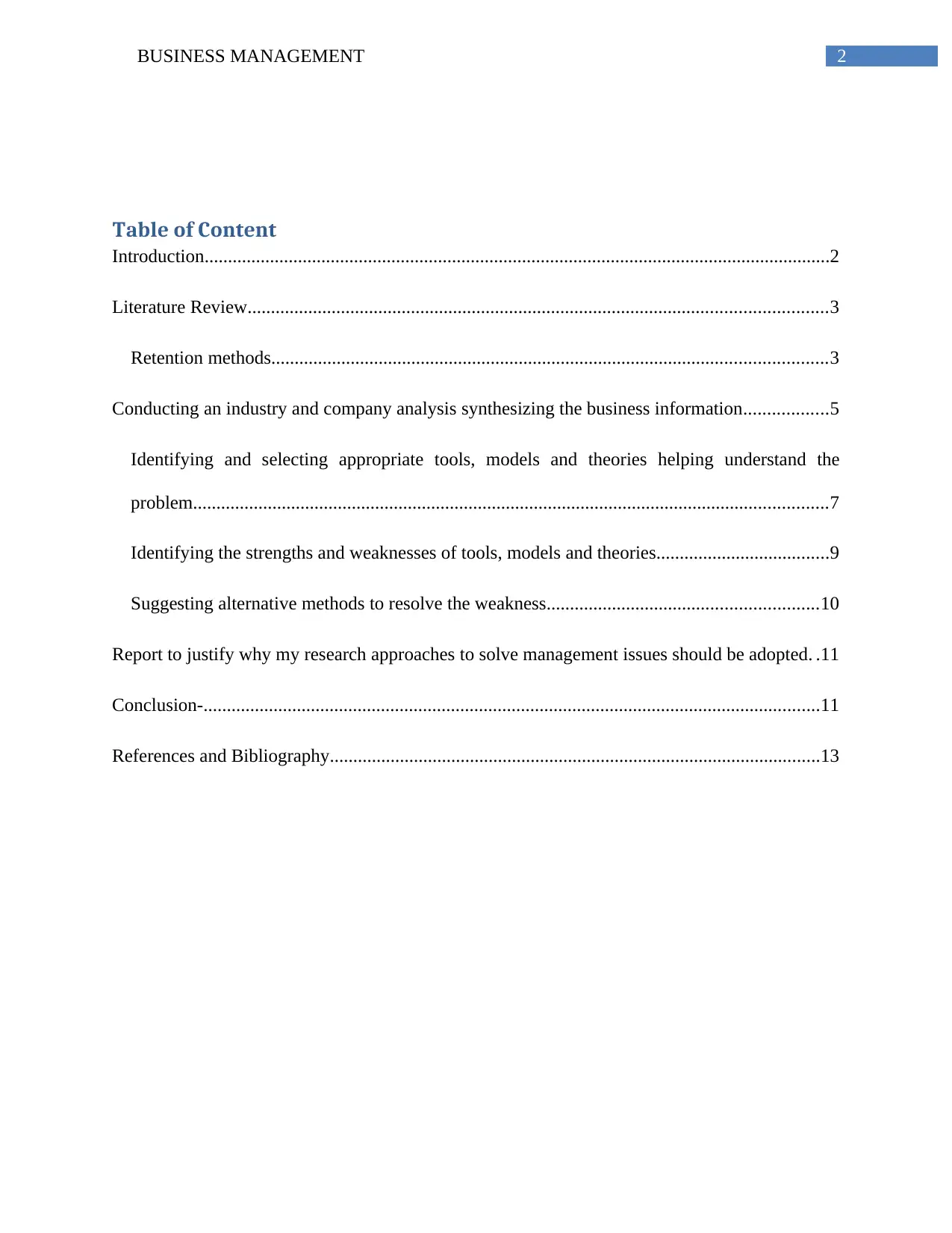
2BUSINESS MANAGEMENT
Table of Content
Introduction......................................................................................................................................2
Literature Review............................................................................................................................3
Retention methods.......................................................................................................................3
Conducting an industry and company analysis synthesizing the business information..................5
Identifying and selecting appropriate tools, models and theories helping understand the
problem........................................................................................................................................7
Identifying the strengths and weaknesses of tools, models and theories.....................................9
Suggesting alternative methods to resolve the weakness..........................................................10
Report to justify why my research approaches to solve management issues should be adopted. .11
Conclusion-....................................................................................................................................11
References and Bibliography.........................................................................................................13
Table of Content
Introduction......................................................................................................................................2
Literature Review............................................................................................................................3
Retention methods.......................................................................................................................3
Conducting an industry and company analysis synthesizing the business information..................5
Identifying and selecting appropriate tools, models and theories helping understand the
problem........................................................................................................................................7
Identifying the strengths and weaknesses of tools, models and theories.....................................9
Suggesting alternative methods to resolve the weakness..........................................................10
Report to justify why my research approaches to solve management issues should be adopted. .11
Conclusion-....................................................................................................................................11
References and Bibliography.........................................................................................................13
⊘ This is a preview!⊘
Do you want full access?
Subscribe today to unlock all pages.

Trusted by 1+ million students worldwide
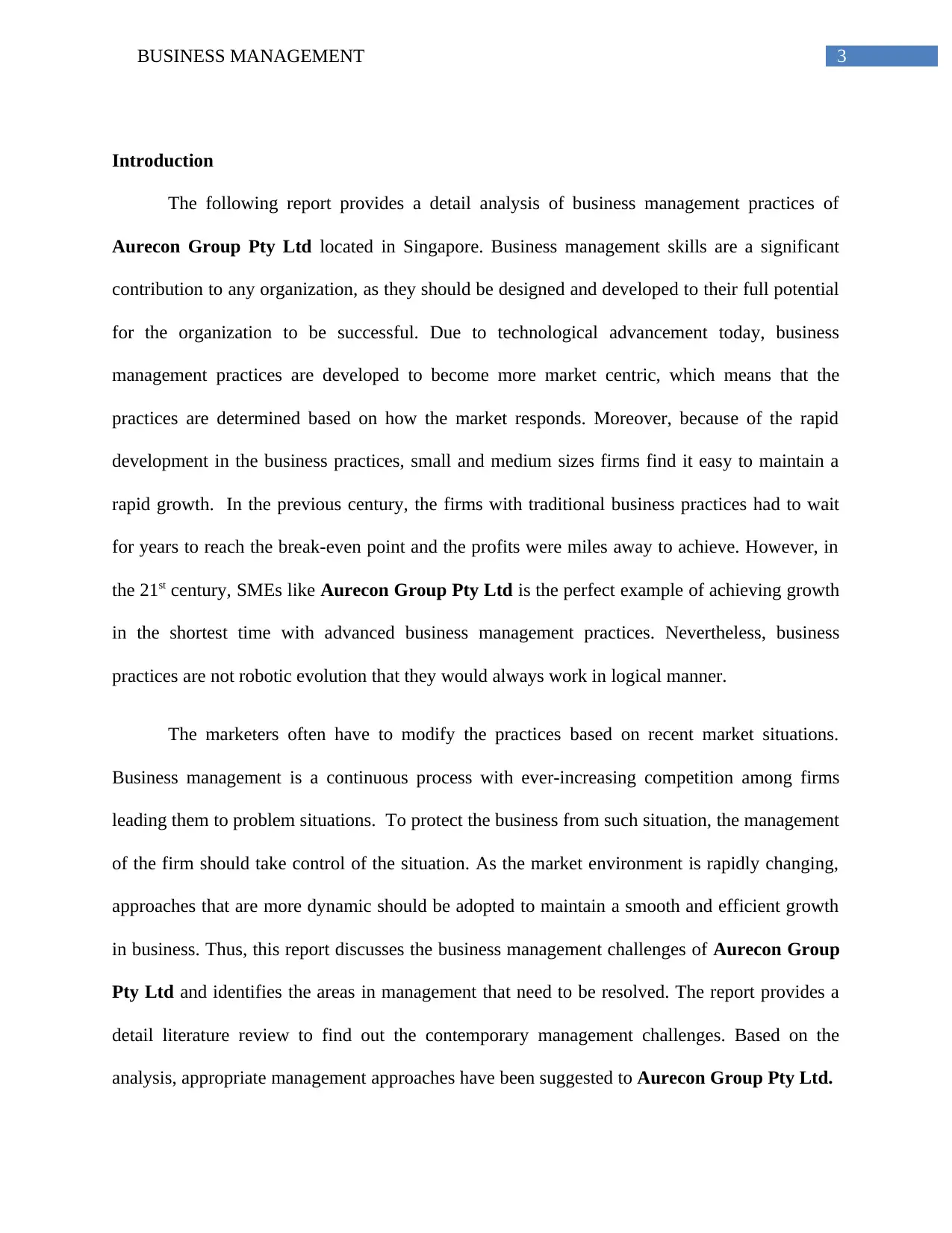
3BUSINESS MANAGEMENT
Introduction
The following report provides a detail analysis of business management practices of
Aurecon Group Pty Ltd located in Singapore. Business management skills are a significant
contribution to any organization, as they should be designed and developed to their full potential
for the organization to be successful. Due to technological advancement today, business
management practices are developed to become more market centric, which means that the
practices are determined based on how the market responds. Moreover, because of the rapid
development in the business practices, small and medium sizes firms find it easy to maintain a
rapid growth. In the previous century, the firms with traditional business practices had to wait
for years to reach the break-even point and the profits were miles away to achieve. However, in
the 21st century, SMEs like Aurecon Group Pty Ltd is the perfect example of achieving growth
in the shortest time with advanced business management practices. Nevertheless, business
practices are not robotic evolution that they would always work in logical manner.
The marketers often have to modify the practices based on recent market situations.
Business management is a continuous process with ever-increasing competition among firms
leading them to problem situations. To protect the business from such situation, the management
of the firm should take control of the situation. As the market environment is rapidly changing,
approaches that are more dynamic should be adopted to maintain a smooth and efficient growth
in business. Thus, this report discusses the business management challenges of Aurecon Group
Pty Ltd and identifies the areas in management that need to be resolved. The report provides a
detail literature review to find out the contemporary management challenges. Based on the
analysis, appropriate management approaches have been suggested to Aurecon Group Pty Ltd.
Introduction
The following report provides a detail analysis of business management practices of
Aurecon Group Pty Ltd located in Singapore. Business management skills are a significant
contribution to any organization, as they should be designed and developed to their full potential
for the organization to be successful. Due to technological advancement today, business
management practices are developed to become more market centric, which means that the
practices are determined based on how the market responds. Moreover, because of the rapid
development in the business practices, small and medium sizes firms find it easy to maintain a
rapid growth. In the previous century, the firms with traditional business practices had to wait
for years to reach the break-even point and the profits were miles away to achieve. However, in
the 21st century, SMEs like Aurecon Group Pty Ltd is the perfect example of achieving growth
in the shortest time with advanced business management practices. Nevertheless, business
practices are not robotic evolution that they would always work in logical manner.
The marketers often have to modify the practices based on recent market situations.
Business management is a continuous process with ever-increasing competition among firms
leading them to problem situations. To protect the business from such situation, the management
of the firm should take control of the situation. As the market environment is rapidly changing,
approaches that are more dynamic should be adopted to maintain a smooth and efficient growth
in business. Thus, this report discusses the business management challenges of Aurecon Group
Pty Ltd and identifies the areas in management that need to be resolved. The report provides a
detail literature review to find out the contemporary management challenges. Based on the
analysis, appropriate management approaches have been suggested to Aurecon Group Pty Ltd.
Paraphrase This Document
Need a fresh take? Get an instant paraphrase of this document with our AI Paraphraser
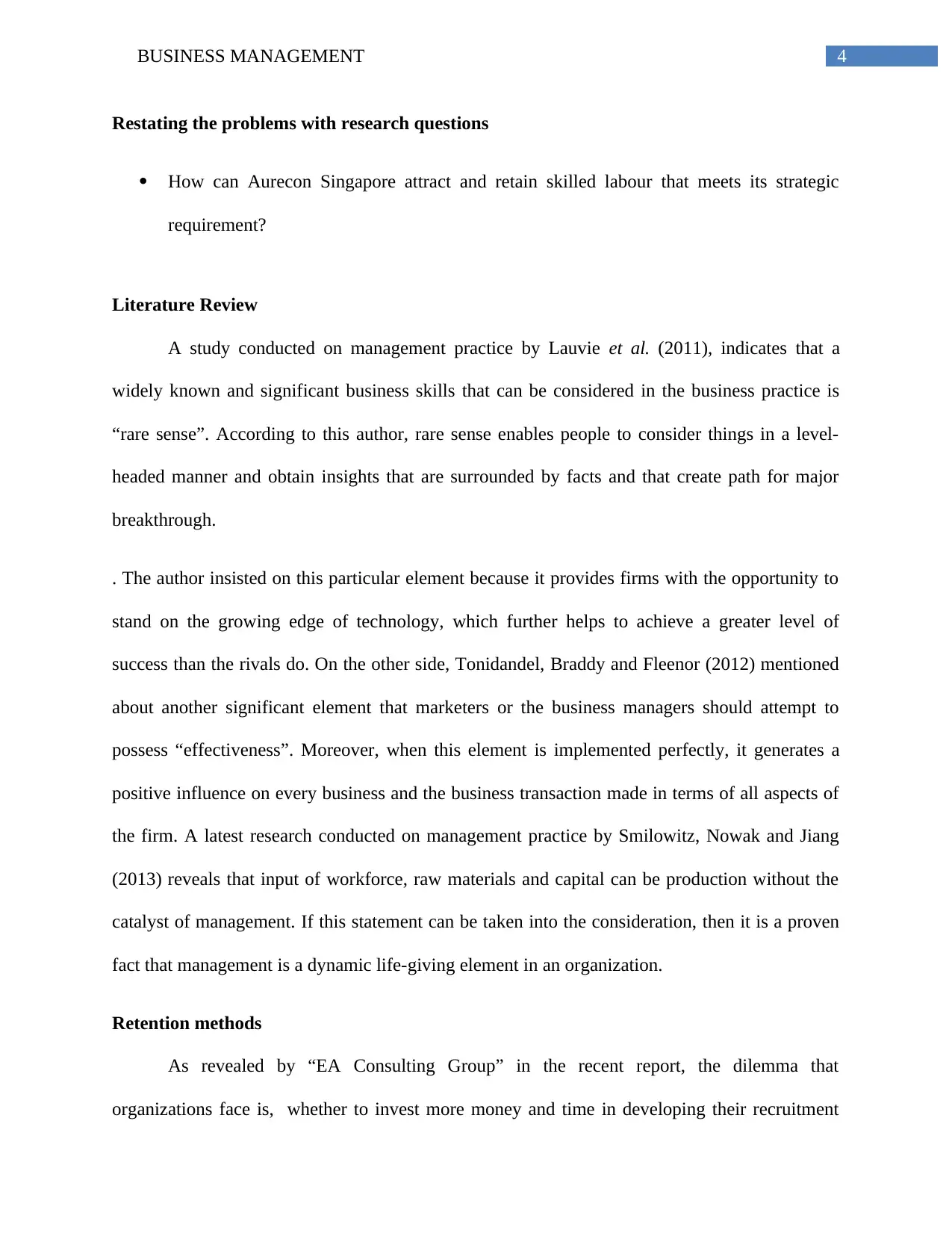
4BUSINESS MANAGEMENT
Restating the problems with research questions
How can Aurecon Singapore attract and retain skilled labour that meets its strategic
requirement?
Literature Review
A study conducted on management practice by Lauvie et al. (2011), indicates that a
widely known and significant business skills that can be considered in the business practice is
“rare sense”. According to this author, rare sense enables people to consider things in a level-
headed manner and obtain insights that are surrounded by facts and that create path for major
breakthrough.
. The author insisted on this particular element because it provides firms with the opportunity to
stand on the growing edge of technology, which further helps to achieve a greater level of
success than the rivals do. On the other side, Tonidandel, Braddy and Fleenor (2012) mentioned
about another significant element that marketers or the business managers should attempt to
possess “effectiveness”. Moreover, when this element is implemented perfectly, it generates a
positive influence on every business and the business transaction made in terms of all aspects of
the firm. A latest research conducted on management practice by Smilowitz, Nowak and Jiang
(2013) reveals that input of workforce, raw materials and capital can be production without the
catalyst of management. If this statement can be taken into the consideration, then it is a proven
fact that management is a dynamic life-giving element in an organization.
Retention methods
As revealed by “EA Consulting Group” in the recent report, the dilemma that
organizations face is, whether to invest more money and time in developing their recruitment
Restating the problems with research questions
How can Aurecon Singapore attract and retain skilled labour that meets its strategic
requirement?
Literature Review
A study conducted on management practice by Lauvie et al. (2011), indicates that a
widely known and significant business skills that can be considered in the business practice is
“rare sense”. According to this author, rare sense enables people to consider things in a level-
headed manner and obtain insights that are surrounded by facts and that create path for major
breakthrough.
. The author insisted on this particular element because it provides firms with the opportunity to
stand on the growing edge of technology, which further helps to achieve a greater level of
success than the rivals do. On the other side, Tonidandel, Braddy and Fleenor (2012) mentioned
about another significant element that marketers or the business managers should attempt to
possess “effectiveness”. Moreover, when this element is implemented perfectly, it generates a
positive influence on every business and the business transaction made in terms of all aspects of
the firm. A latest research conducted on management practice by Smilowitz, Nowak and Jiang
(2013) reveals that input of workforce, raw materials and capital can be production without the
catalyst of management. If this statement can be taken into the consideration, then it is a proven
fact that management is a dynamic life-giving element in an organization.
Retention methods
As revealed by “EA Consulting Group” in the recent report, the dilemma that
organizations face is, whether to invest more money and time in developing their recruitment
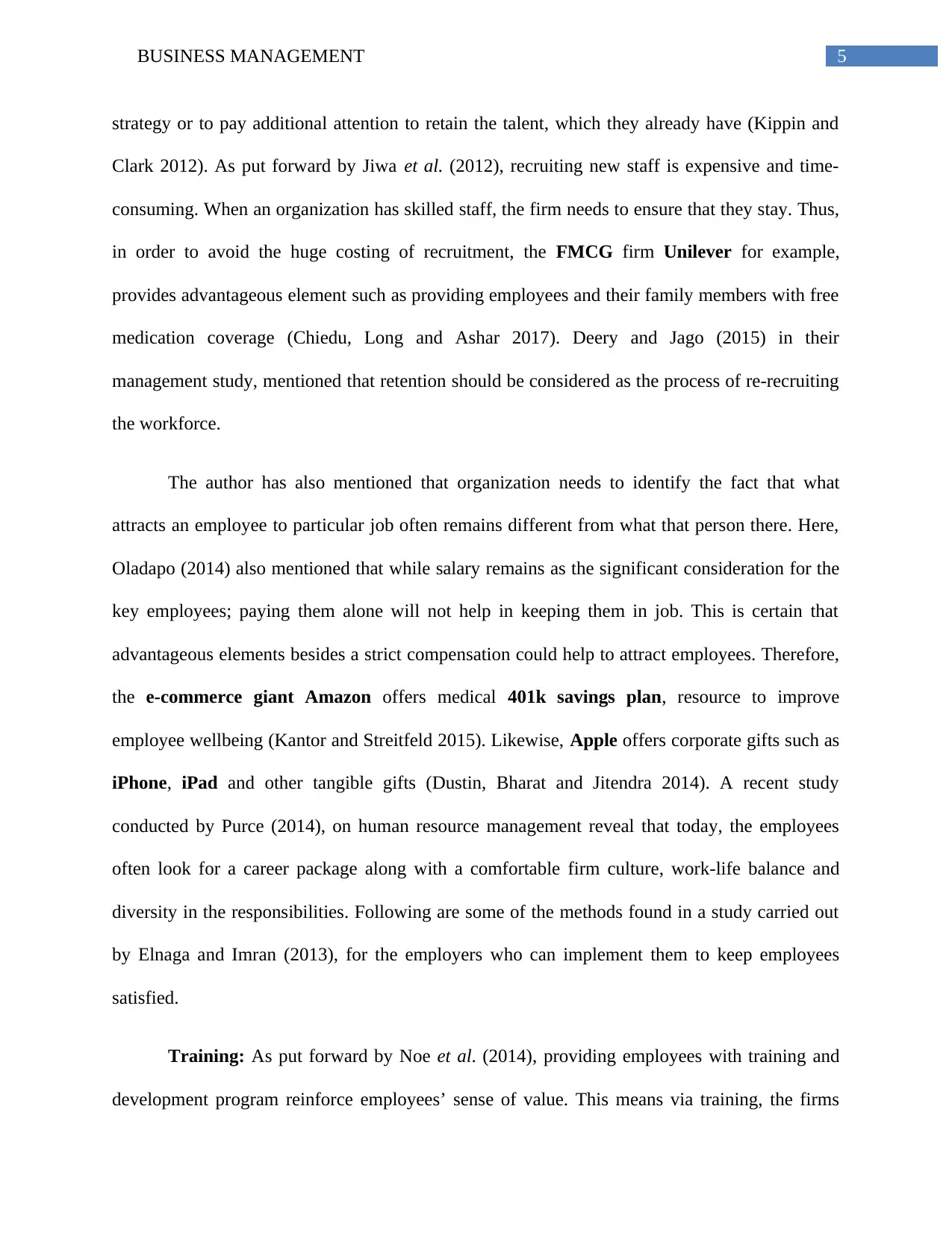
5BUSINESS MANAGEMENT
strategy or to pay additional attention to retain the talent, which they already have (Kippin and
Clark 2012). As put forward by Jiwa et al. (2012), recruiting new staff is expensive and time-
consuming. When an organization has skilled staff, the firm needs to ensure that they stay. Thus,
in order to avoid the huge costing of recruitment, the FMCG firm Unilever for example,
provides advantageous element such as providing employees and their family members with free
medication coverage (Chiedu, Long and Ashar 2017). Deery and Jago (2015) in their
management study, mentioned that retention should be considered as the process of re-recruiting
the workforce.
The author has also mentioned that organization needs to identify the fact that what
attracts an employee to particular job often remains different from what that person there. Here,
Oladapo (2014) also mentioned that while salary remains as the significant consideration for the
key employees; paying them alone will not help in keeping them in job. This is certain that
advantageous elements besides a strict compensation could help to attract employees. Therefore,
the e-commerce giant Amazon offers medical 401k savings plan, resource to improve
employee wellbeing (Kantor and Streitfeld 2015). Likewise, Apple offers corporate gifts such as
iPhone, iPad and other tangible gifts (Dustin, Bharat and Jitendra 2014). A recent study
conducted by Purce (2014), on human resource management reveal that today, the employees
often look for a career package along with a comfortable firm culture, work-life balance and
diversity in the responsibilities. Following are some of the methods found in a study carried out
by Elnaga and Imran (2013), for the employers who can implement them to keep employees
satisfied.
Training: As put forward by Noe et al. (2014), providing employees with training and
development program reinforce employees’ sense of value. This means via training, the firms
strategy or to pay additional attention to retain the talent, which they already have (Kippin and
Clark 2012). As put forward by Jiwa et al. (2012), recruiting new staff is expensive and time-
consuming. When an organization has skilled staff, the firm needs to ensure that they stay. Thus,
in order to avoid the huge costing of recruitment, the FMCG firm Unilever for example,
provides advantageous element such as providing employees and their family members with free
medication coverage (Chiedu, Long and Ashar 2017). Deery and Jago (2015) in their
management study, mentioned that retention should be considered as the process of re-recruiting
the workforce.
The author has also mentioned that organization needs to identify the fact that what
attracts an employee to particular job often remains different from what that person there. Here,
Oladapo (2014) also mentioned that while salary remains as the significant consideration for the
key employees; paying them alone will not help in keeping them in job. This is certain that
advantageous elements besides a strict compensation could help to attract employees. Therefore,
the e-commerce giant Amazon offers medical 401k savings plan, resource to improve
employee wellbeing (Kantor and Streitfeld 2015). Likewise, Apple offers corporate gifts such as
iPhone, iPad and other tangible gifts (Dustin, Bharat and Jitendra 2014). A recent study
conducted by Purce (2014), on human resource management reveal that today, the employees
often look for a career package along with a comfortable firm culture, work-life balance and
diversity in the responsibilities. Following are some of the methods found in a study carried out
by Elnaga and Imran (2013), for the employers who can implement them to keep employees
satisfied.
Training: As put forward by Noe et al. (2014), providing employees with training and
development program reinforce employees’ sense of value. This means via training, the firms
⊘ This is a preview!⊘
Do you want full access?
Subscribe today to unlock all pages.

Trusted by 1+ million students worldwide
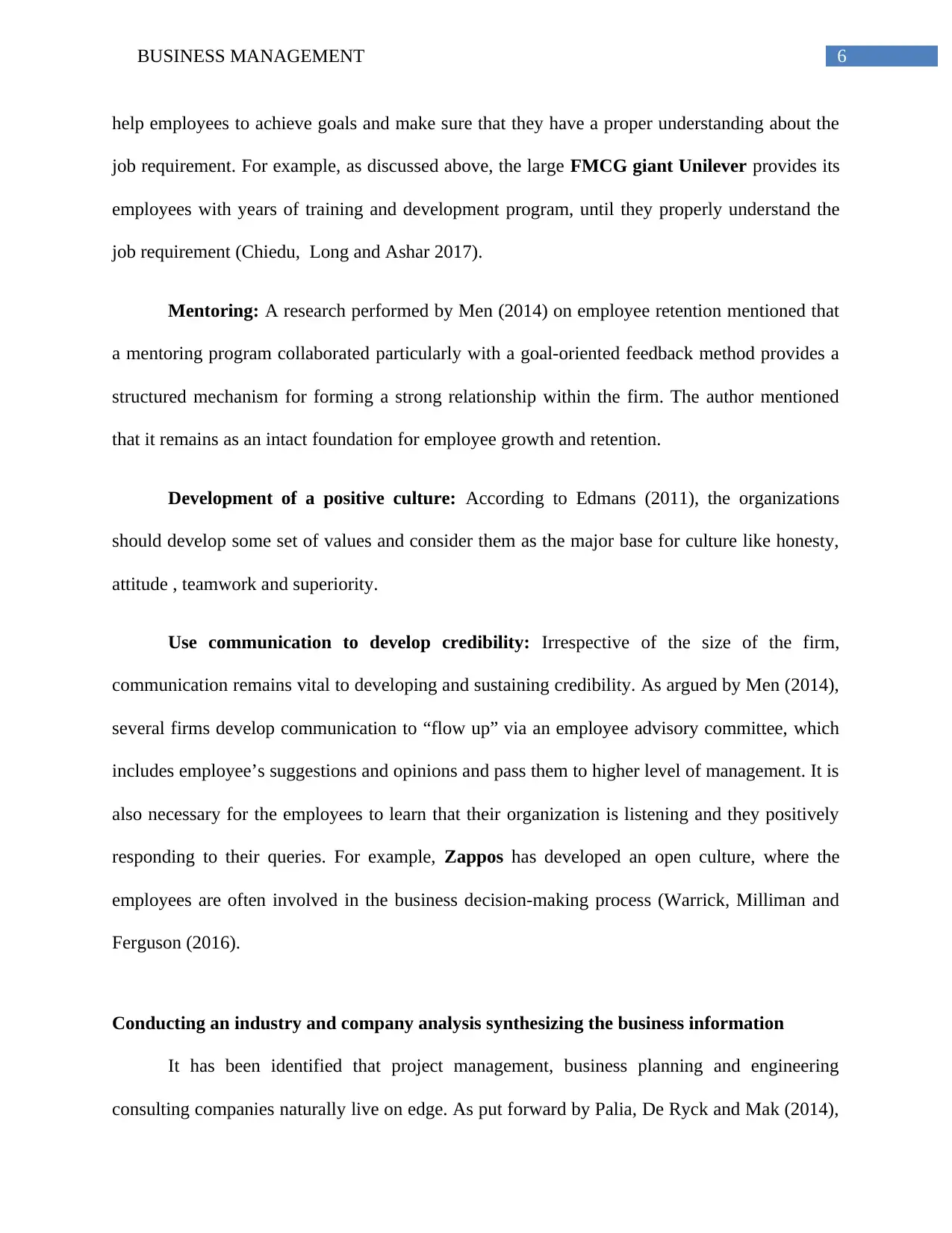
6BUSINESS MANAGEMENT
help employees to achieve goals and make sure that they have a proper understanding about the
job requirement. For example, as discussed above, the large FMCG giant Unilever provides its
employees with years of training and development program, until they properly understand the
job requirement (Chiedu, Long and Ashar 2017).
Mentoring: A research performed by Men (2014) on employee retention mentioned that
a mentoring program collaborated particularly with a goal-oriented feedback method provides a
structured mechanism for forming a strong relationship within the firm. The author mentioned
that it remains as an intact foundation for employee growth and retention.
Development of a positive culture: According to Edmans (2011), the organizations
should develop some set of values and consider them as the major base for culture like honesty,
attitude , teamwork and superiority.
Use communication to develop credibility: Irrespective of the size of the firm,
communication remains vital to developing and sustaining credibility. As argued by Men (2014),
several firms develop communication to “flow up” via an employee advisory committee, which
includes employee’s suggestions and opinions and pass them to higher level of management. It is
also necessary for the employees to learn that their organization is listening and they positively
responding to their queries. For example, Zappos has developed an open culture, where the
employees are often involved in the business decision-making process (Warrick, Milliman and
Ferguson (2016).
Conducting an industry and company analysis synthesizing the business information
It has been identified that project management, business planning and engineering
consulting companies naturally live on edge. As put forward by Palia, De Ryck and Mak (2014),
help employees to achieve goals and make sure that they have a proper understanding about the
job requirement. For example, as discussed above, the large FMCG giant Unilever provides its
employees with years of training and development program, until they properly understand the
job requirement (Chiedu, Long and Ashar 2017).
Mentoring: A research performed by Men (2014) on employee retention mentioned that
a mentoring program collaborated particularly with a goal-oriented feedback method provides a
structured mechanism for forming a strong relationship within the firm. The author mentioned
that it remains as an intact foundation for employee growth and retention.
Development of a positive culture: According to Edmans (2011), the organizations
should develop some set of values and consider them as the major base for culture like honesty,
attitude , teamwork and superiority.
Use communication to develop credibility: Irrespective of the size of the firm,
communication remains vital to developing and sustaining credibility. As argued by Men (2014),
several firms develop communication to “flow up” via an employee advisory committee, which
includes employee’s suggestions and opinions and pass them to higher level of management. It is
also necessary for the employees to learn that their organization is listening and they positively
responding to their queries. For example, Zappos has developed an open culture, where the
employees are often involved in the business decision-making process (Warrick, Milliman and
Ferguson (2016).
Conducting an industry and company analysis synthesizing the business information
It has been identified that project management, business planning and engineering
consulting companies naturally live on edge. As put forward by Palia, De Ryck and Mak (2014),
Paraphrase This Document
Need a fresh take? Get an instant paraphrase of this document with our AI Paraphraser
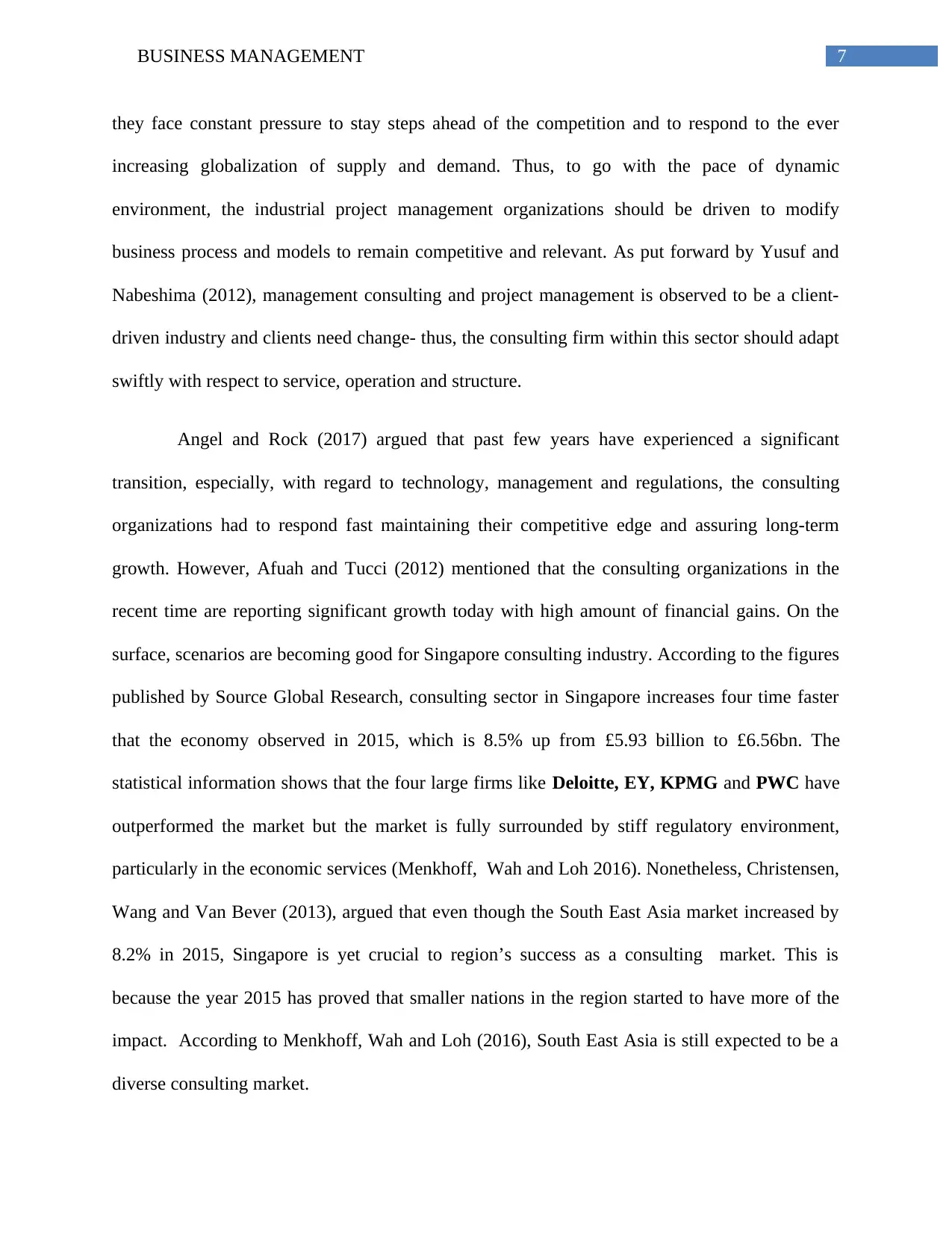
7BUSINESS MANAGEMENT
they face constant pressure to stay steps ahead of the competition and to respond to the ever
increasing globalization of supply and demand. Thus, to go with the pace of dynamic
environment, the industrial project management organizations should be driven to modify
business process and models to remain competitive and relevant. As put forward by Yusuf and
Nabeshima (2012), management consulting and project management is observed to be a client-
driven industry and clients need change- thus, the consulting firm within this sector should adapt
swiftly with respect to service, operation and structure.
Angel and Rock (2017) argued that past few years have experienced a significant
transition, especially, with regard to technology, management and regulations, the consulting
organizations had to respond fast maintaining their competitive edge and assuring long-term
growth. However, Afuah and Tucci (2012) mentioned that the consulting organizations in the
recent time are reporting significant growth today with high amount of financial gains. On the
surface, scenarios are becoming good for Singapore consulting industry. According to the figures
published by Source Global Research, consulting sector in Singapore increases four time faster
that the economy observed in 2015, which is 8.5% up from £5.93 billion to £6.56bn. The
statistical information shows that the four large firms like Deloitte, EY, KPMG and PWC have
outperformed the market but the market is fully surrounded by stiff regulatory environment,
particularly in the economic services (Menkhoff, Wah and Loh 2016). Nonetheless, Christensen,
Wang and Van Bever (2013), argued that even though the South East Asia market increased by
8.2% in 2015, Singapore is yet crucial to region’s success as a consulting market. This is
because the year 2015 has proved that smaller nations in the region started to have more of the
impact. According to Menkhoff, Wah and Loh (2016), South East Asia is still expected to be a
diverse consulting market.
they face constant pressure to stay steps ahead of the competition and to respond to the ever
increasing globalization of supply and demand. Thus, to go with the pace of dynamic
environment, the industrial project management organizations should be driven to modify
business process and models to remain competitive and relevant. As put forward by Yusuf and
Nabeshima (2012), management consulting and project management is observed to be a client-
driven industry and clients need change- thus, the consulting firm within this sector should adapt
swiftly with respect to service, operation and structure.
Angel and Rock (2017) argued that past few years have experienced a significant
transition, especially, with regard to technology, management and regulations, the consulting
organizations had to respond fast maintaining their competitive edge and assuring long-term
growth. However, Afuah and Tucci (2012) mentioned that the consulting organizations in the
recent time are reporting significant growth today with high amount of financial gains. On the
surface, scenarios are becoming good for Singapore consulting industry. According to the figures
published by Source Global Research, consulting sector in Singapore increases four time faster
that the economy observed in 2015, which is 8.5% up from £5.93 billion to £6.56bn. The
statistical information shows that the four large firms like Deloitte, EY, KPMG and PWC have
outperformed the market but the market is fully surrounded by stiff regulatory environment,
particularly in the economic services (Menkhoff, Wah and Loh 2016). Nonetheless, Christensen,
Wang and Van Bever (2013), argued that even though the South East Asia market increased by
8.2% in 2015, Singapore is yet crucial to region’s success as a consulting market. This is
because the year 2015 has proved that smaller nations in the region started to have more of the
impact. According to Menkhoff, Wah and Loh (2016), South East Asia is still expected to be a
diverse consulting market.
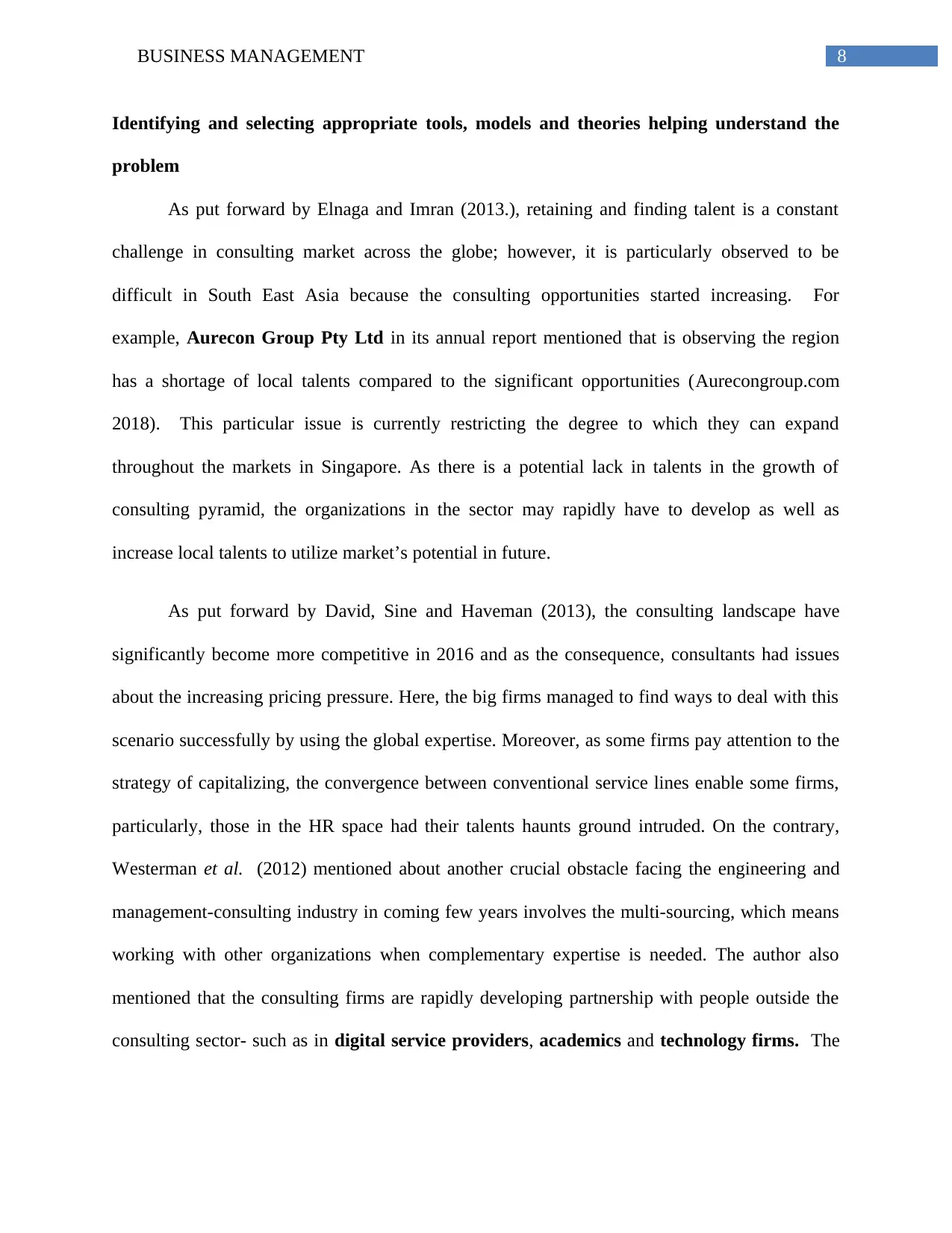
8BUSINESS MANAGEMENT
Identifying and selecting appropriate tools, models and theories helping understand the
problem
As put forward by Elnaga and Imran (2013.), retaining and finding talent is a constant
challenge in consulting market across the globe; however, it is particularly observed to be
difficult in South East Asia because the consulting opportunities started increasing. For
example, Aurecon Group Pty Ltd in its annual report mentioned that is observing the region
has a shortage of local talents compared to the significant opportunities (Aurecongroup.com
2018). This particular issue is currently restricting the degree to which they can expand
throughout the markets in Singapore. As there is a potential lack in talents in the growth of
consulting pyramid, the organizations in the sector may rapidly have to develop as well as
increase local talents to utilize market’s potential in future.
As put forward by David, Sine and Haveman (2013), the consulting landscape have
significantly become more competitive in 2016 and as the consequence, consultants had issues
about the increasing pricing pressure. Here, the big firms managed to find ways to deal with this
scenario successfully by using the global expertise. Moreover, as some firms pay attention to the
strategy of capitalizing, the convergence between conventional service lines enable some firms,
particularly, those in the HR space had their talents haunts ground intruded. On the contrary,
Westerman et al. (2012) mentioned about another crucial obstacle facing the engineering and
management-consulting industry in coming few years involves the multi-sourcing, which means
working with other organizations when complementary expertise is needed. The author also
mentioned that the consulting firms are rapidly developing partnership with people outside the
consulting sector- such as in digital service providers, academics and technology firms. The
Identifying and selecting appropriate tools, models and theories helping understand the
problem
As put forward by Elnaga and Imran (2013.), retaining and finding talent is a constant
challenge in consulting market across the globe; however, it is particularly observed to be
difficult in South East Asia because the consulting opportunities started increasing. For
example, Aurecon Group Pty Ltd in its annual report mentioned that is observing the region
has a shortage of local talents compared to the significant opportunities (Aurecongroup.com
2018). This particular issue is currently restricting the degree to which they can expand
throughout the markets in Singapore. As there is a potential lack in talents in the growth of
consulting pyramid, the organizations in the sector may rapidly have to develop as well as
increase local talents to utilize market’s potential in future.
As put forward by David, Sine and Haveman (2013), the consulting landscape have
significantly become more competitive in 2016 and as the consequence, consultants had issues
about the increasing pricing pressure. Here, the big firms managed to find ways to deal with this
scenario successfully by using the global expertise. Moreover, as some firms pay attention to the
strategy of capitalizing, the convergence between conventional service lines enable some firms,
particularly, those in the HR space had their talents haunts ground intruded. On the contrary,
Westerman et al. (2012) mentioned about another crucial obstacle facing the engineering and
management-consulting industry in coming few years involves the multi-sourcing, which means
working with other organizations when complementary expertise is needed. The author also
mentioned that the consulting firms are rapidly developing partnership with people outside the
consulting sector- such as in digital service providers, academics and technology firms. The
⊘ This is a preview!⊘
Do you want full access?
Subscribe today to unlock all pages.

Trusted by 1+ million students worldwide
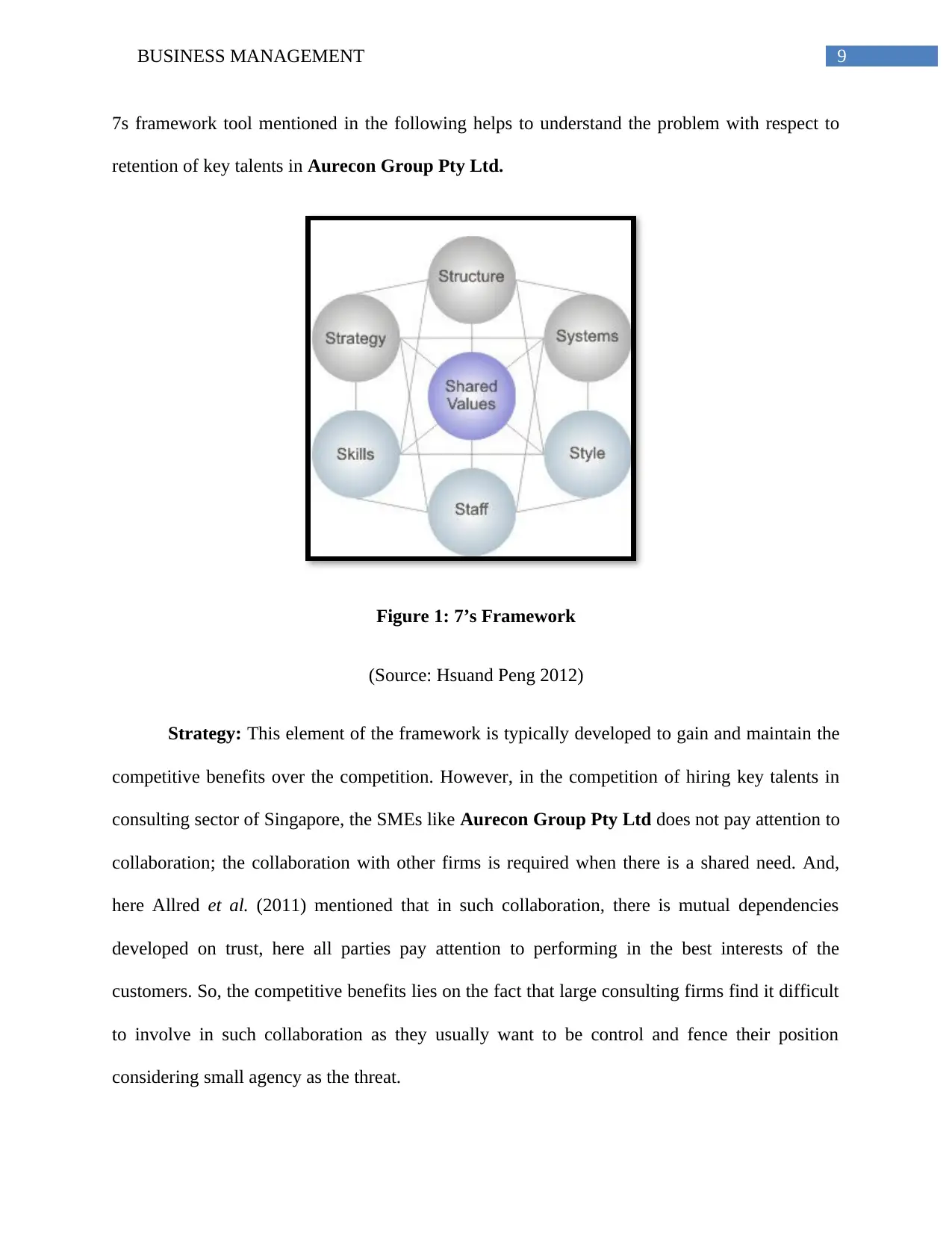
9BUSINESS MANAGEMENT
7s framework tool mentioned in the following helps to understand the problem with respect to
retention of key talents in Aurecon Group Pty Ltd.
Figure 1: 7’s Framework
(Source: Hsuand Peng 2012)
Strategy: This element of the framework is typically developed to gain and maintain the
competitive benefits over the competition. However, in the competition of hiring key talents in
consulting sector of Singapore, the SMEs like Aurecon Group Pty Ltd does not pay attention to
collaboration; the collaboration with other firms is required when there is a shared need. And,
here Allred et al. (2011) mentioned that in such collaboration, there is mutual dependencies
developed on trust, here all parties pay attention to performing in the best interests of the
customers. So, the competitive benefits lies on the fact that large consulting firms find it difficult
to involve in such collaboration as they usually want to be control and fence their position
considering small agency as the threat.
7s framework tool mentioned in the following helps to understand the problem with respect to
retention of key talents in Aurecon Group Pty Ltd.
Figure 1: 7’s Framework
(Source: Hsuand Peng 2012)
Strategy: This element of the framework is typically developed to gain and maintain the
competitive benefits over the competition. However, in the competition of hiring key talents in
consulting sector of Singapore, the SMEs like Aurecon Group Pty Ltd does not pay attention to
collaboration; the collaboration with other firms is required when there is a shared need. And,
here Allred et al. (2011) mentioned that in such collaboration, there is mutual dependencies
developed on trust, here all parties pay attention to performing in the best interests of the
customers. So, the competitive benefits lies on the fact that large consulting firms find it difficult
to involve in such collaboration as they usually want to be control and fence their position
considering small agency as the threat.
Paraphrase This Document
Need a fresh take? Get an instant paraphrase of this document with our AI Paraphraser
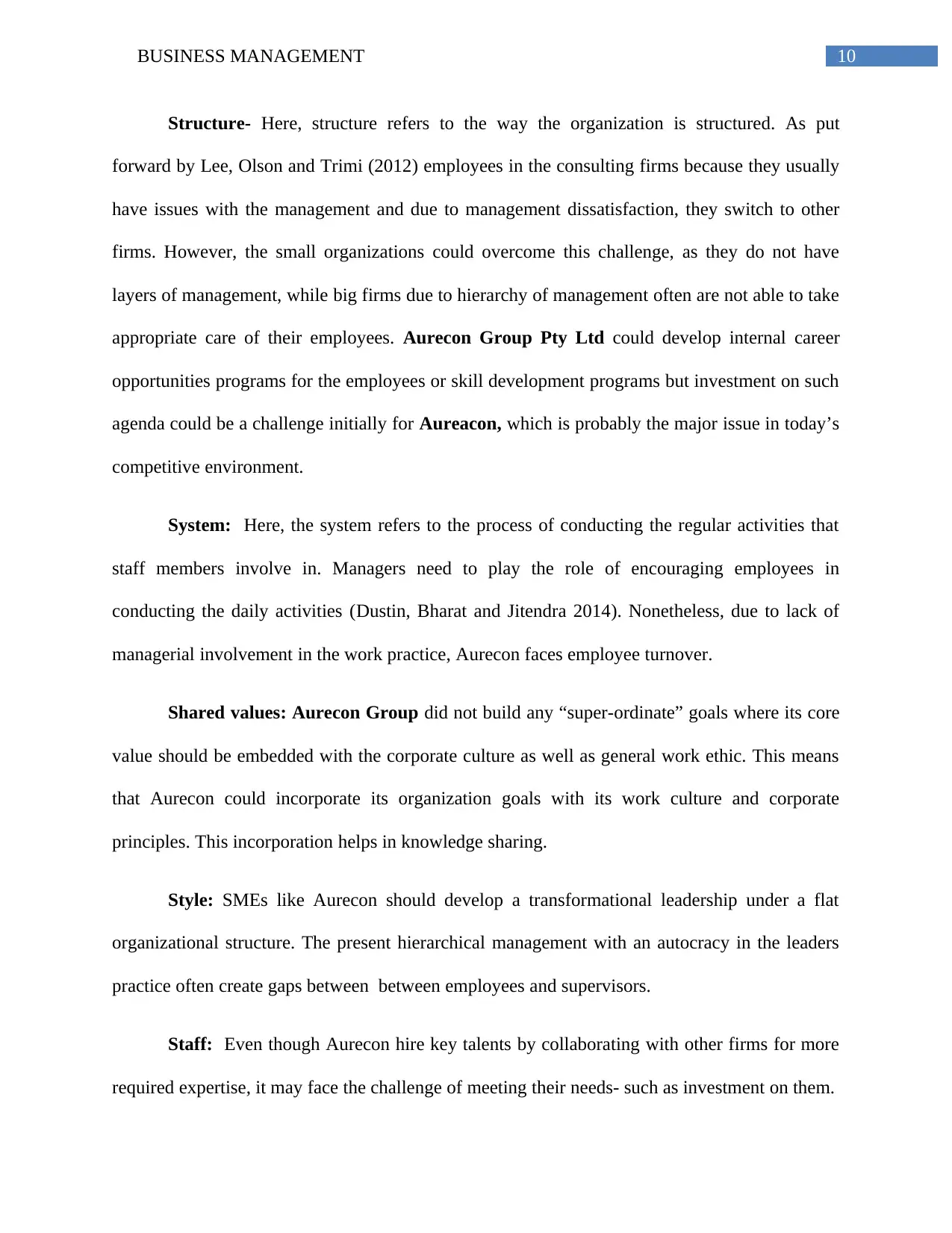
10BUSINESS MANAGEMENT
Structure- Here, structure refers to the way the organization is structured. As put
forward by Lee, Olson and Trimi (2012) employees in the consulting firms because they usually
have issues with the management and due to management dissatisfaction, they switch to other
firms. However, the small organizations could overcome this challenge, as they do not have
layers of management, while big firms due to hierarchy of management often are not able to take
appropriate care of their employees. Aurecon Group Pty Ltd could develop internal career
opportunities programs for the employees or skill development programs but investment on such
agenda could be a challenge initially for Aureacon, which is probably the major issue in today’s
competitive environment.
System: Here, the system refers to the process of conducting the regular activities that
staff members involve in. Managers need to play the role of encouraging employees in
conducting the daily activities (Dustin, Bharat and Jitendra 2014). Nonetheless, due to lack of
managerial involvement in the work practice, Aurecon faces employee turnover.
Shared values: Aurecon Group did not build any “super-ordinate” goals where its core
value should be embedded with the corporate culture as well as general work ethic. This means
that Aurecon could incorporate its organization goals with its work culture and corporate
principles. This incorporation helps in knowledge sharing.
Style: SMEs like Aurecon should develop a transformational leadership under a flat
organizational structure. The present hierarchical management with an autocracy in the leaders
practice often create gaps between between employees and supervisors.
Staff: Even though Aurecon hire key talents by collaborating with other firms for more
required expertise, it may face the challenge of meeting their needs- such as investment on them.
Structure- Here, structure refers to the way the organization is structured. As put
forward by Lee, Olson and Trimi (2012) employees in the consulting firms because they usually
have issues with the management and due to management dissatisfaction, they switch to other
firms. However, the small organizations could overcome this challenge, as they do not have
layers of management, while big firms due to hierarchy of management often are not able to take
appropriate care of their employees. Aurecon Group Pty Ltd could develop internal career
opportunities programs for the employees or skill development programs but investment on such
agenda could be a challenge initially for Aureacon, which is probably the major issue in today’s
competitive environment.
System: Here, the system refers to the process of conducting the regular activities that
staff members involve in. Managers need to play the role of encouraging employees in
conducting the daily activities (Dustin, Bharat and Jitendra 2014). Nonetheless, due to lack of
managerial involvement in the work practice, Aurecon faces employee turnover.
Shared values: Aurecon Group did not build any “super-ordinate” goals where its core
value should be embedded with the corporate culture as well as general work ethic. This means
that Aurecon could incorporate its organization goals with its work culture and corporate
principles. This incorporation helps in knowledge sharing.
Style: SMEs like Aurecon should develop a transformational leadership under a flat
organizational structure. The present hierarchical management with an autocracy in the leaders
practice often create gaps between between employees and supervisors.
Staff: Even though Aurecon hire key talents by collaborating with other firms for more
required expertise, it may face the challenge of meeting their needs- such as investment on them.
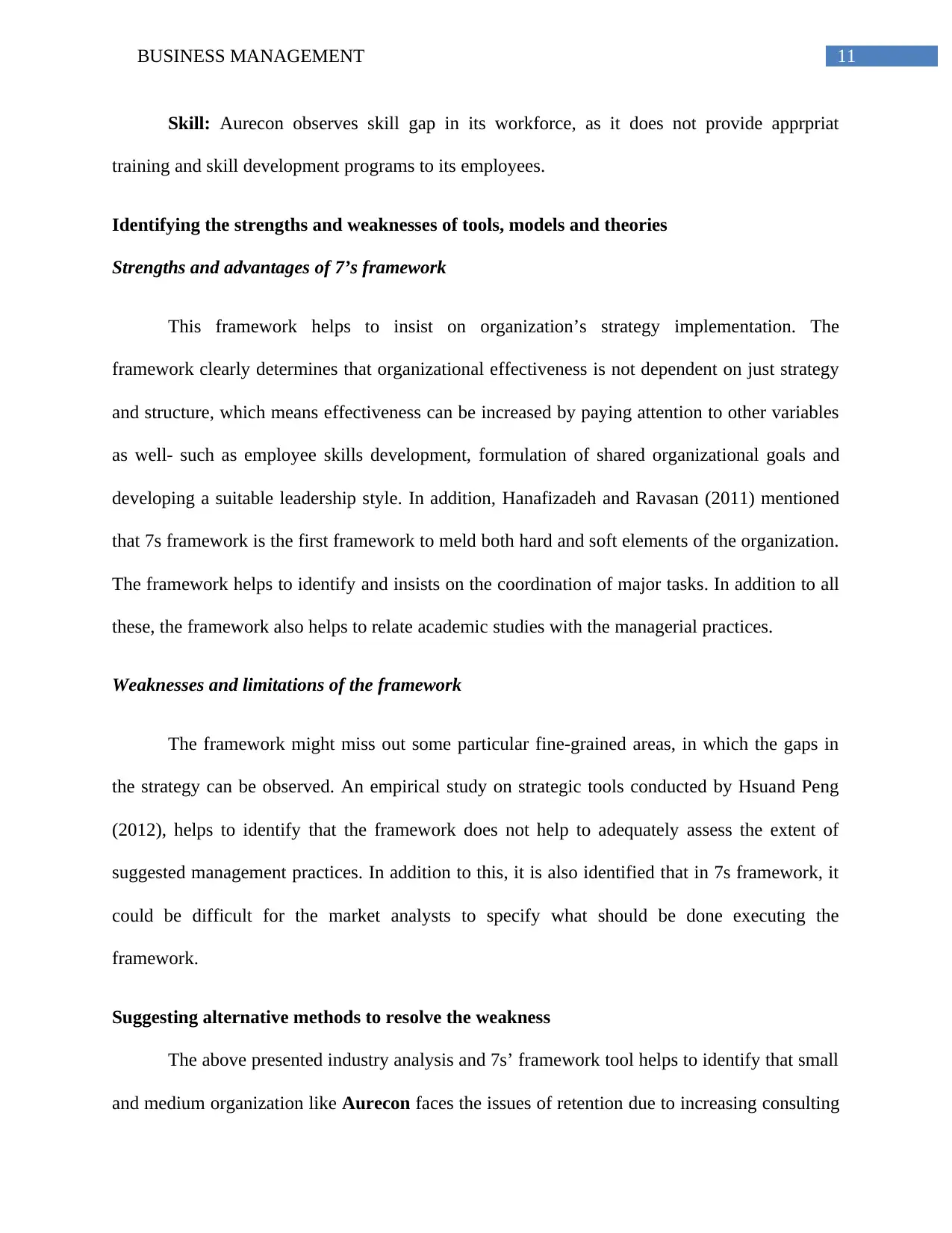
11BUSINESS MANAGEMENT
Skill: Aurecon observes skill gap in its workforce, as it does not provide apprpriat
training and skill development programs to its employees.
Identifying the strengths and weaknesses of tools, models and theories
Strengths and advantages of 7’s framework
This framework helps to insist on organization’s strategy implementation. The
framework clearly determines that organizational effectiveness is not dependent on just strategy
and structure, which means effectiveness can be increased by paying attention to other variables
as well- such as employee skills development, formulation of shared organizational goals and
developing a suitable leadership style. In addition, Hanafizadeh and Ravasan (2011) mentioned
that 7s framework is the first framework to meld both hard and soft elements of the organization.
The framework helps to identify and insists on the coordination of major tasks. In addition to all
these, the framework also helps to relate academic studies with the managerial practices.
Weaknesses and limitations of the framework
The framework might miss out some particular fine-grained areas, in which the gaps in
the strategy can be observed. An empirical study on strategic tools conducted by Hsuand Peng
(2012), helps to identify that the framework does not help to adequately assess the extent of
suggested management practices. In addition to this, it is also identified that in 7s framework, it
could be difficult for the market analysts to specify what should be done executing the
framework.
Suggesting alternative methods to resolve the weakness
The above presented industry analysis and 7s’ framework tool helps to identify that small
and medium organization like Aurecon faces the issues of retention due to increasing consulting
Skill: Aurecon observes skill gap in its workforce, as it does not provide apprpriat
training and skill development programs to its employees.
Identifying the strengths and weaknesses of tools, models and theories
Strengths and advantages of 7’s framework
This framework helps to insist on organization’s strategy implementation. The
framework clearly determines that organizational effectiveness is not dependent on just strategy
and structure, which means effectiveness can be increased by paying attention to other variables
as well- such as employee skills development, formulation of shared organizational goals and
developing a suitable leadership style. In addition, Hanafizadeh and Ravasan (2011) mentioned
that 7s framework is the first framework to meld both hard and soft elements of the organization.
The framework helps to identify and insists on the coordination of major tasks. In addition to all
these, the framework also helps to relate academic studies with the managerial practices.
Weaknesses and limitations of the framework
The framework might miss out some particular fine-grained areas, in which the gaps in
the strategy can be observed. An empirical study on strategic tools conducted by Hsuand Peng
(2012), helps to identify that the framework does not help to adequately assess the extent of
suggested management practices. In addition to this, it is also identified that in 7s framework, it
could be difficult for the market analysts to specify what should be done executing the
framework.
Suggesting alternative methods to resolve the weakness
The above presented industry analysis and 7s’ framework tool helps to identify that small
and medium organization like Aurecon faces the issues of retention due to increasing consulting
⊘ This is a preview!⊘
Do you want full access?
Subscribe today to unlock all pages.

Trusted by 1+ million students worldwide
1 out of 18
Related Documents
Your All-in-One AI-Powered Toolkit for Academic Success.
+13062052269
info@desklib.com
Available 24*7 on WhatsApp / Email
![[object Object]](/_next/static/media/star-bottom.7253800d.svg)
Unlock your academic potential
Copyright © 2020–2025 A2Z Services. All Rights Reserved. Developed and managed by ZUCOL.




